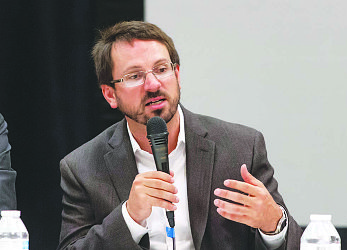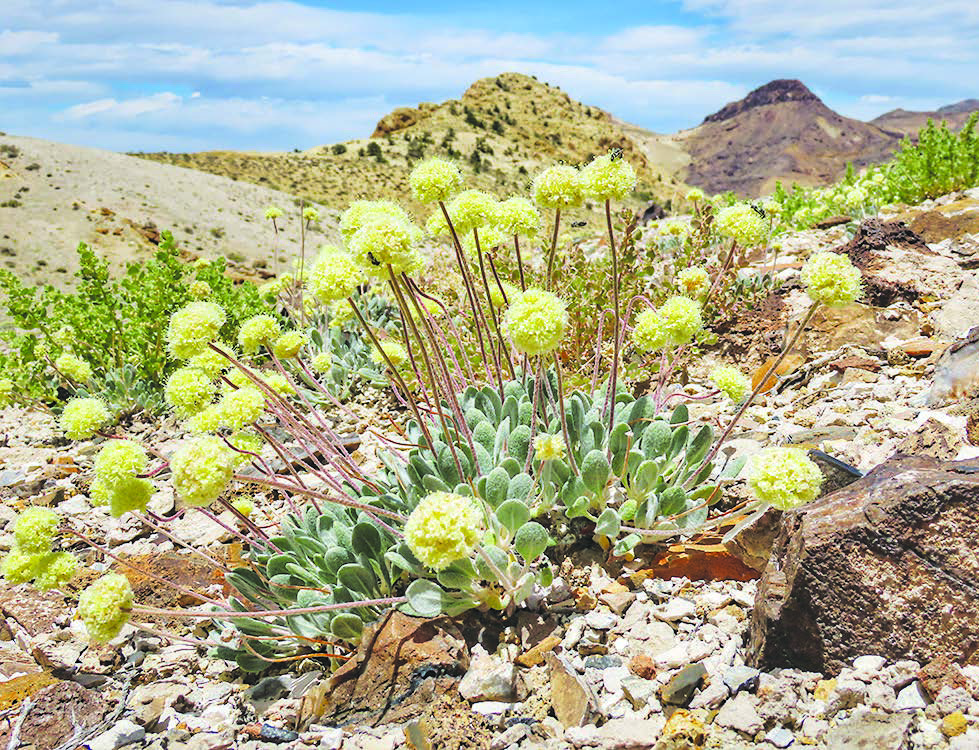
Of the proposed mine, Patrick Donnelly from the Center for Biological Diversity says, “It would be truly unprecedented for a single project to destroy almost a quarter of the designated critical habitat of an endangered species.”

Tiehm’s buck wheat, designated by the federal government as an endangered species, is a perennial with blue-gray leaves and yellow flowers that grows exclusively on about 10 acres of Bureau of Land Management property in Esmeralda County. Australian company Ioneer wants to build a 7,000-acre open pit lithium and boron mine that would encroach on some of the land where Tiehm’s buckwheat grows.
A proposed lithium mine in Esmeralda County that poses a threat to a rare desert wildflower could also damage the Silver Peak Range Mountains and Fish Lake Valley, environmentalists opposing the project said Monday.
Tiehm’s buck wheat is a perennial with blue-gray leaves and yellow flowers that grows exclusively on about 10 acres of Bureau of Land Management property near the proposed mine. The U.S. Fish and Wildlife Service designated a 910-acre critical habitat for the plant in 2022, after declaring it endangered.
Australian company Ioneer first proposed the 7,000-acre open pit lithium and boron mine in 2021 on BLM territory roughly200milesnorthwest ofLasVegas.
The project’s environmental impact statement shows 22% of the buckwheat’s designated limited habitat would be affected, said Patrick Donnelly, the Great Basin director at the Center for Biological Diversity. “It would be truly unprecedented for a single project to destroy almost a quarter of the designated critical habitat of an endangered species,” Donnelly said.
The development, roads, traffic and other elements of the mine would bring in dust, pollutants, invasive species and herbicides that would further damage the plant, he added. The proposed 963-foot deep pit mine within 15 feet of the Tiehm’s buckwheat habitat is also at high risk for collapse over time,” Donnelly said.
“It’s almost a certainty that Tiehm’s buckwheat will end up at the bottom of the open pit … maybe not in five years or 10 years, but in 100 or 200 years it’s guaranteed,” Donnelly said.
He said a mine that deep would create a cone of depression that would draw water away from Fish Lake Valley, which is home to two more sensitive species — the Fish Lake Valley Tui chub and Tecopa Bird’s beak. Fermina Stevens, director of the nonprofit Western Shoshone Defense Project, said the proposed mine was on ancestral Western Shoshonel and.
“It is our understanding that Nevada is the hotbed for critical mineral extraction, and we are concerned with the speed at which projects are being pushed through,” Stevens said. She said the Bureau of Land Management hadn’t consulted with theWestern Shoshone tribe. “It seems their new mission is to pave the way for mineral extraction without regard to concern or opposition,” Stevens said.
Naomi Fraga, conservation director at the California Botanic Garden, said Ioneer’s proposed plan to avoid the plant would not protect it from the project. If 22% of the 10-acre habitat is destroyed by mining, the entire habitat would be degraded and altered, she said. New roads Ioneer built during the exploration phase worsened environmental hazards, paving the way for invasive species like saltlover, which grows at the site.
She said the water Ioneer would use for dust mitigation would spread invasive weeds by watering seeds blownin on the roads. “There needs to be identified a plan as to how, potentially, to treat these invasive species,” Fraga said. In 2021, the Center for Biological Diversity sued the U.S. Department of the Interior after Ioneer’s exploratory mining damaged the plant’s scant natural habitat.
In its review, the U.S. Fish and Wildlife Service named the drilling and development as the primary threat to the plant, followed by livestock grazing, invasive plant species, native animals feeding on the plants and climate change. Following the endangered designation, Ioneer submitted a new plan of operations to BLM in 2022 and funded a study on the plant later published in Ecosphere.
The study found the plant played a key role for pollinators and spider species, and its unique soil requirements would make transplanting or growing in any other environment difficult. “The only published study of Tiehm’s buckwheat is a study they funded that did not support their attempts to either relocate the buckwheat or provide evidence that the buckwheat could live outside of its current range,” she said. grace.darocha@gmg vegas.com / 702-948-7854 / @gracedarocha

